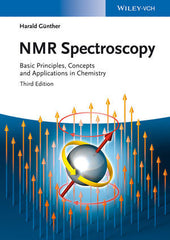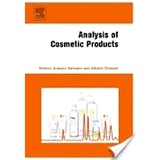NMR Spectroscopy: Basic Principles, Concepts and Applications in Chemistry, 3rd Edition By Harald Gunther
NMR Spectroscopy: Basic Principles, Concepts and Applications in Chemistry, 3rd Edition
important for determining the 3D-structure of molecules.
This new edition of the popular classic has a clear style and a highly practical, mostly non-mathematical approach. Many examples are taken from organic and organometallic chemistry, making this book an invaluable guide to undergraduate and graduate students of organic chemistry, biochemistry, spectroscopy or physical chemistry, and to researchers using this well-established and extremely important technique. Problems and solutions are included.
Preface XV
1 Introduction 1
1.1 Literature 8
1.2 Units and Constants 9
References 10
Part I Basic Principles and Applications 11
2 The Physical Basis of the Nuclear Magnetic Resonance Experiment.
Part I 13
2.1 The Quantum Mechanical Model for the Isolated Proton 13
2.2 Classical Description of the NMR Experiment 16
2.3 Experimental Verification of Quantized Angular Momentum and of the Resonance Equation 17
2.4 The NMR Experiment on Compact Matter and the Principle of the NMR Spectrometer 19
2.4.1 How to Measure an NMR Spectrum 19
2.5 Magnetic Properties of Nuclei beyond the Proton 25
References 27
3 The Proton Magnetic Resonance Spectra of Organic Molecules – Chemical Shift and Spin–Spin Coupling 29
3.1 The Chemical Shift 29
3.1.1 Chemical Shift Measurements 32
3.1.2 Integration of the Spectrum 35
3.1.3 Structural Dependence of the Resonance Frequency – A General Survey 37
3.2 Spin–Spin Coupling 41
3.2.1 Simple Rules for the Interpretation of Multiplet Structures 46
3.2.2 Spin–Spin Coupling with Other Nuclei 49
3.2.2.1 Nuclei of Spin I = 12 49
3.2.2.2 Nuclei of Spin I > 12 51
3.2.3 Limits of the Simple Splitting Rules 52
3.2.3.1 The Notion of Magnetic Equivalence 52
3.2.3.2 Significance of the Ratio J/ν0δ 56
3.2.4 Spin–Spin Decoupling 58
3.2.5 Two-Dimensional NMR – the COSY Experiment 60
3.2.6 Structural Dependence of Spin–Spin Coupling – A General Survey 62
References 66
4 General Experimental Aspects of Nuclear Magnetic Resonance Spectroscopy 67
4.1 Sample Preparation and Sample Tubes 67
4.2 Internal and External Standards; Solvent Effects 70
4.3 Tuning the Spectrometer 74
4.4 Increasing the Sensitivity 78
4.5 Measurement of Spectra at Different Temperatures 81
References 83
Textbooks 83
Review Articles 83
5 Proton Chemical Shifts and Spin–Spin Coupling Constants as Functions of Structure 85
5.1 Origin of Proton Chemical Shifts 86
5.1.1 Influence of the Electron Density at the Proton 87
5.1.2 Influence of the Electron Density at Neighboring Carbon Atoms 87
5.1.3 The Influence of Induced Magnetic Moments of Neighboring Atoms and Bonds 94
5.1.4 Ring Current Effect in Cyclic Conjugated π-Systems 101
5.1.5 Alternative Methods to Measure Diatropicity 110
5.1.6 Diamagnetic Anisotropy of the Cyclopropane Ring 113
5.1.7 Electric Field Effect of Polar Groups and the van-derWaals Effect 114
5.1.8 Chemical Shifts through Hydrogen Bonding 117
5.1.9 Chemical Shifts of Protons in Organometallic Compounds 119
5.1.10 Solvent Effects 120
5.1.11 Empirical Substituent Constants 121
5.1.11.1 Tables of Proton Resonances in Organic Molecules 122
5.2 Proton–Proton Spin–Spin Coupling and Chemical Structure 122
5.2.1 The Geminal Coupling Constant (2J) 123
5.2.1.1 Dependence on the Hybridization of the Methylene Carbon 123
5.2.1.2 Effect of Substituents 124
5.2.1.3 A Molecular Orbital Model for the Interpretation of Substituent Effects on 2J 126
5.2.2 The Vicinal Coupling Constant (3J) 128
5.2.2.1 Dependence on the Dihedral Angle 129
5.2.2.2 Dependence upon the C–C Bond Length, Rμν 130
5.2.2.3 Dependence on HCC Valence Angles 132
5.2.2.4 Substituent Effects 133
5.2.3 Long-Range Coupling Constants (4J, 5J) 137
5.2.3.1 Saturated Systems 138
5.2.3.2 Unsaturated Systems 139
5.2.4 Through-Space and Dipolar Coupling 143
5.2.5 Tables of Spin–Spin Coupling Constants in Organic Molecules 144
References 147
Monograph 148
Review Articles 148
6 The Analysis of High-Resolution Nuclear Magnetic Resonance Spectra 149
6.1 Notation for Spin Systems 150
6.2 Quantum Mechanical Formalism 151
6.2.1 The Schr¨odinger Equation 151
6.3 The Hamilton Operator for High-Resolution Nuclear Magnetic Resonance Spectroscopy 153
6.4 Calculation of Individual Spin Systems 155
6.4.1 Stationary States of a Single Nucleus A 156
6.4.2 Two Nuclei without Spin–Spin Interaction (Jij = 0); Selection Rules 156
6.4.3 Two Nuclei with Spin–Spin Interaction (Jij = 0) 158
6.4.3.1 The A2 Case and the Variational Method 158
6.4.3.2 Calculation of the Relative Intensities 162
6.4.3.3 Symmetric and Antisymmetric Wave Functions 163
6.4.4 The AB System 164
6.4.5 The AX System and the First-Order Approximation 167
6.4.6 General Rules for the Treatment of More Complex Spin Systems 170
6.5 Calculation of the Parameters νi and Jij from the Experimental Spectrum 174
6.5.1 Direct Analysis of the AB System 175
6.5.2 Spin Systems with Three Nuclei 177
6.5.2.1 The AB2 (A2B) System 177
6.5.2.2 The Particle Spin 181
6.5.2.3 The ABX System 182
6.5.3 Spin Systems with Four Nuclei – The AAXX System 192
6.5.4 Computer Analysis 206
References 209
Textbooks 210
Review Articles 210
7 The Influence of Molecular Symmetry and Chirality on Proton Magnetic Resonance Spectra 211
7.1 Spectral Types and Structural Isomerism 211
7.2 Influence of Chirality on the NMR Spectrum 216
7.3 Analysis of Degenerate Spin Systems by Means of 13C Satellites and H/D Substitution 226
References 229
Review Articles 230
Part II Advanced Methods and Applications 231
8 The Physical Basis of the Nuclear Magnetic Resonance Experiment.
Part II: Pulse and Fourier-Transform NMR 233
8.1 The NMR Signal by Pulse Excitation 234
8.1.1 Resonance for the Isolated Nucleus 234
8.1.2 Pulse Excitation for a Macroscopic Sample 236
8.2 Relaxation Effects 239
8.2.1 Longitudinal or Spin–Lattice Relaxation 239
8.2.2 Transverse or Spin–Spin Relaxation 243
8.2.3 Experiments for Measuring Relaxation Times 247
8.2.3.1 T1 Measurements – the Inversion Recovery Experiment 247
8.2.3.2 The Spin Echo Experiment 248
8.3 Pulse Fourier-Transform (FT) NMR Spectroscopy 249
8.3.1 Pulse Excitation of Entire NMR Spectra 250
8.3.2 The Receiver Signal and its Analysis 252
8.4 Experimental Aspects of Pulse Fourier-Transform Spectroscopy 254
8.4.1 The FT NMR Spectrometer – Basic Principles and Operation 254
8.4.1.1 The Computer and the Analog–Digital Converter (ADC) 254
8.4.1.2 RF Sources of an FT NMR Spectrometer 258
8.4.1.3 Transmitter and Signal Phase 259
8.4.1.4 Selective Excitation and Shaped Pulses in FT NMR Spectroscopy 260
8.4.1.5 Pulse Calibration 263
8.4.1.6 Composite Pulses 264
8.4.1.7 Single and Quadrature Detection 264
8.4.1.8 Phase Cycles 266
8.4.2 Complications in FT NMR Spectroscopy 267
8.4.3 Data Improvement 269
8.5 Double Resonance Experiments 272
8.5.1 Homonuclear Double Resonance – Spin Decoupling 272
8.5.2 Heteronuclear Double Resonance 273
8.5.3 Broadband Decoupling 275
8.5.3.1 Broadband Decoupling by CW Modulation 275
8.5.3.2 Broadband Decoupling by Pulse Methods 276
8.5.4 Off-Resonance Decoupling 277
References 279
Textbooks 280
Review articles 280
9 Two-Dimensional Nuclear Magnetic Resonance Spectroscopy 281
9.1 Principles of Two-Dimensional NMR Spectroscopy 281
9.1.1 Graphical Presentation of Two-Dimensional NMR Spectra 284
9.2 The Spin Echo Experiment in Modern NMR Spectroscopy 285
9.2.1 Time-Dependence of Transverse Magnetization 285
9.2.2 Chemical Shifts and Spin–Spin Coupling Constants and the Spin Echo Experiment 286
9.3 Homonuclear Two-Dimensional Spin Echo Spectroscopy: Separation of the Parameters J and δ for Proton NMR Spectra 289
9.3.1 Applications of Homonuclear 1H J,δ-Spectroscopy 291
9.3.2 Practical Aspects of 1H J,δ-Spectroscopy 294
9.4 The COSY Experiment – Two-Dimensional 1H,1H Shift Correlations 296
9.4.1 Some Experimental Aspects of 2D-COSY Spectroscopy 300
9.4.2 Artifacts in COSY Spectra 302
9.4.3 Modifications of the Jeener Pulse Sequence 304
9.4.3.1 COSY-45 304
9.4.3.2 Long-Range COSY (COSY-LR) 305
9.4.3.3 COSY with Double Quantum Filter (COSY-DQF) 307
9.5 The Product Operator Formalism 309
9.5.1 Phenomenon of Coherence 309
9.5.2 Operator Basis for an AX System 311
9.5.3 Zero- and Multiple-Quantum Coherences 312
9.5.4 Evolution of Operators 313
9.5.5 The Observables 316
9.5.6 The COSY Experiment within the Product Operator Formalism 317
9.5.7 The COSY Experiment with Double-Quantum Filter (COSY-DQF) 320
9.6 Phase Cycles 322
9.6.1 COSY Experiment 324
9.7 Gradient Enhanced Spectroscopy 326
9.8 Universal Building Blocks for Pulse Sequences 329
9.8.1 Constant Time Experiments: ω1-Decoupled COSY 329
9.8.2 BIRD Pulses 329
9.8.3 Low-Pass Filter 330
9.8.4 z-Filter 331
9.9 Homonuclear Shift Correlation by Double Quantum Selection of AX Systems – the 2D-INADEQUATE Experiment 331
9.10 Single-Scan 2D NMR 336
References 337
Textbooks and Monographs 338
Methods Oriented 338
Application Oriented 338
Review articles 338
10 More 1D and 2D NMR Experiments: the Nuclear Overhauser Effect – Polarization Transfer – Spin Lock Experiments – 3D NMR 341
10.1 The Overhauser Effect 341
10.1.1 Original Overhauser Effect 341
10.1.2 Nuclear Overhauser Effect (NOE) 343
10.1.3 One-Dimensional Homonuclear NOE Experiments 345
10.1.3.1 NOE Measurements of Relative Distances between Protons 345
10.1.3.2 NOE Difference Spectroscopy 346
10.1.4 Complications during NOE Measurements 348
10.1.5 Two-Dimensional Homonuclear Overhauser Spectroscopy (NOESY) 350
10.1.6 Two-Dimensional Heteronuclear Overhauser Spectroscopy (HOESY) 355
10.2 Polarization Transfer Experiments 357
10.2.1 SPI Experiment 357
10.2.2 INEPT Pulse Sequence 360
10.3 Rotating Frame Experiments 364
10.3.1 Spin Lock and Hartmann–Hahn Condition 364
10.3.2 Spin Lock Experiments in Solution 366
10.3.2.1 Homonuclear Hartmann–Hahn or TOCSY Experiments 366
10.3.2.2 One-Dimensional Selective TOCSY Spectroscopy 368
10.3.2.3 ROESY Experiment 369
10.4 Multidimensional NMR Experiments 371
References 376
Textbooks 376
Review articles 376
11 Carbon-13 Nuclear Magnetic Resonance Spectroscopy 377
11.1 Historical Development and the Most Important Areas of Application 378
11.2 Experimental Aspects of Carbon-13 Nuclear Magnetic Resonance Spectroscopy 381
11.2.1 Gated Decoupling 382
11.2.2 Assignment Techniques 383
11.2.2.1 Multiplicity Selection with the Heteronuclear Spin Echo Experiment (SEFT, APT) 383
11.2.2.2 Polarization Transfer Experiments 387
11.2.2.3 Heteronuclear Two-Dimensional 1H,13C Chemical Shift Correlation 389
11.2.2.4 The 13C,13C INADEQUATE Experiment 398
11.2.2.5 Heteronuclear J, δ Spectroscopy 401
11.2.2.6 Assignment Techniques with Selective Excitation 403
11.2.2.7 Alternative Assignment Techniques 405
11.3 Carbon-13 Chemical Shifts 407
11.3.1 Theoretical Models 409
11.3.2 Empirical Correlations 418
11.4 Carbon-13 Spin–Spin Coupling Constants 420
11.4.1 Carbon-13 Coupling Constants and Chemical Structure 422
11.4.1.1 13C,13C Coupling Constants 422
11.4.1.2 13C,1H Coupling Constants 424
11.4.1.3 13C,X Coupling Constants 427
11.5 Carbon-13 Spin–Lattice Relaxation Rates 428
References 430
Textbooks and Monographs 430
Review articles 430
12 Selected Heteronuclei 431
12.1 Semimetals and Non-metals with the Exception of Hydrogen and Carbon 435
12.1.1 Boron-11 435
12.1.1.1 Referencing and Chemical Shifts 437
12.1.1.2 Polyhedral Boranes 438
12.1.2 Nitrogen-15 439
12.1.2.1 Referencing and Chemical Shifts 441
12.1.2.2 Spin-Spin Coupling 445
12.1.3 Oxygen-17 445
12.1.3.1 Referencing and Chemical Shifts 446
12.1.4 Fluorine-19 447
12.1.4.1 Referencing and Chemical Shifts 448
12.1.4.2 Spin-Spin Coupling 452
12.1.5 Silicon-29 454
12.1.5.1 Referencing and Chemical Shifts 454
12.1.5.2 Spin-Spin Coupling 457
12.1.6 Phosphorus-31 458
12.1.6.1 Referencing and Chemical Shifts 458
12.1.6.2 Spin-Spin Coupling 461
12.2 Main Group Metals 462
12.2.1 Lithium-6,7 462
12.2.1.1 Referencing and Chemical Shifts 463
12.2.1.2 Spin-Spin Coupling 463
12.2.2 Aluminum-27 468
12.2.2.1 Referencing and Chemical Shifts 469
12.2.3 Tin-119 471
12.2.3.1 Referencing and Chemical Shifts 472
12.2.3.2 Spin-Spin Coupling 473
12.3 Transition Metals 474
12.3.1 Vanadium-51 476
12.3.2 Platinum-195 480
12.3.2.1 Spin-Spin Coupling 482
12.3.3 Cobalt-59 482
12.3.4 Copper-63 484
12.3.5 Rhodium-103 485
12.3.6 Cadmium-113 488
12.3.7 Iron-57 489
12.3.8 Manganese-55 491
12.3.9 Molybdenum-95 492
12.3.10 Tungsten-183 492
12.3.11 Mercury-199 494
12.3.12 Osmium-187 496
References 496
Textbooks 498
Monographs 498
General Review Articles 498
Selected Review Articles dealing with Individual Nuclei not cited Above 498
13 Influence of Dynamic Effects on Nuclear Magnetic Resonance Spectra 501
13.1 Exchange of Protons between Positions with Different Larmor Frequencies 501
13.1.1 Quantitative Description of Dynamic Nuclear Magnetic Resonance 504
13.1.2 Relationships to Reaction Kinetics 505
13.1.3 Approximate Solutions and Sources of Error 509
13.1.4 More Complex Exchange Phenomena 512
13.1.5 Application of Inversion-Recovery Experiments to the Determination of Rate Constants 513
13.1.6 Two-Dimensional Exchange Spectroscopy (EXSY) 514
13.1.7 Measurements of First-Order Rate Constants by Integration 516
13.2 Internal Dynamics of Organic Molecules 517
13.2.1 Hindrance to Internal Rotation 518
13.2.1.1 Bonds with Partial Double Bond Character 518
13.2.1.2 Substituted Ethanes 521
13.2.2 Inversion of Configuration 523
13.2.3 Ring Inversion 526
13.2.4 Valence Tautomerism and Bond Shifts 532
13.2.5 Dynamic Processes in Organometallic Compounds and Carbocations 542
13.3 Intermolecular Exchange Processes 549
13.4 Line Broadening by Fast Relaxing Neighboring Nuclei 554
References 555
Textbooks 556
Review Articles 556
14 Nuclear Magnetic Resonance of Partially Oriented Molecules and Solid State NMR 557
14.1 Nuclear Magnetic Resonance of Partially Oriented Molecules 557
14.1.1 Nuclear Magnetic Resonance in Liquid Crystals 558
14.1.2 Other Alignment Methods – Residual Dipolar Couplings 565
14.2 High-Resolution Solid State Nuclear Magnetic Resonance Spectroscopy 568
14.2.1 Experimental Techniques of High-Resolution Solid State NMR Spectroscopy 570
14.2.1.1 Line Narrowing 570
14.2.1.2 Assignment Methods 576
14.2.1.3 Quadrupolar Nuclei 577
14.2.2 Applications of High-Resolution Solid State NMR Spectroscopy 580
14.2.2.1 Spin 12 Nuclei 580
14.2.2.2 Quadrupolar Nuclei 584
14.2.2.3 Dynamic Processes 588
References 589
Textbooks 590
Review Articles 590
15 Selected Topics of Nuclear Magnetic Resonance Spectroscopy 591
15.1 Isotope Effects in Nuclear Magnetic Resonance 591
15.1.1 Isotopic Perturbation of Equilibrium 595
15.2 Nuclear Magnetic Resonance Spectroscopy of Paramagnetic Materials 597
15.2.1 Contact Shifts 597
15.2.2 Pseudo-contact Shifts – Shift Reagents 599
15.3 Chemically Induced Dynamic Nuclear Polarization (CIDNP) 604
15.3.1 Energy Polarization (Net Effect) 605
15.3.2 Entropy Polarization (Multiplet Effect) 608
15.3.3 The Kaptein Rules 611
15.4 Diffusion-Controlled Nuclear Magnetic Resonance Spectroscopy – DOSY 612
15.4.1 Measurement of Diffusion Coefficients 612
15.4.2 Mixture Analysis by Diffusion-Ordered Spectroscopy (DOSY) 615
15.5 Unconventional Methods for Sensitivity Enhancement – Hyperpolarization 617
15.5.1 Hydrogenation Reactions and the Effect of para-Hydrogen 617
15.5.2 Optical Pumping – Xenon-129 NMR 621
15.5.3 Dynamic Nuclear Polarization 623
15.6 Nuclear Magnetic Resonance in Biochemistry and Medicine 625
15.6.1 Biomolecules 625
15.6.2 Peptides and Proteins 627
15.6.3 Nucleic Acids 634
15.6.4 Oligo- and Polysaccharides 636
15.6.5 Solvent Suppression 639
15.6.6 NMR of Body Fluids and In-vivo NMR Spectroscopy 640
15.6.7 NMR Imaging 642
References 647
Review Articles 648
Appendix 649
1 The ‘‘Ring Current Effect’’ of the Benzene Nucleus 649
2 Tables of Proton Resonance Frequencies and Substituent Effects S(δ) 650
2.1 Substituent Effects S(δ) or SCS 652
3 Tables of 1H,1H Coupling Constants 654
4 Chemical Shifts and Substuent Effects S(δ) of 13C Resonances in Organic Compounds 659
5 The Hamiltonian Operator in Polar Coordinates 664
6 Intensity Distribution in A-multiplets Caused by n Neighbouring X-Nuclei with Spin I = 1 or I = 32 664
7 Commutable Operators 665
8 The Fz Operator 665
9 Equations for the Direct Analysis of AABB Spectra 666
10 Bloch Equations 667
11 Bloch Equations Modified for Chemical Exchange 668
12 Phase Behavior of Cross Peaks in 2D Nuclear Overhauser Spectroscopy (NOESY), Rotating-Frame Overhauser Spectroscopy (ROESY), and Total Correlation Spectroscopy (TOCSY) and Chemical Exchange (EXSY) Experiments 671
13 The International System (SI) of Units (MKSA System) 672
References 673
Solutions for Exercises 675
Glossary 691
Index 695
Institute, Pittsburgh, USA. He then became an assistant at the Institute of Organic Chemistry at the University of Cologne, Germany, where he also completed his habilitation. He became Professor of Organic Chemistry at the University of Cologne in 1970, and at the University of Siegen, Germany, in 1978.


















